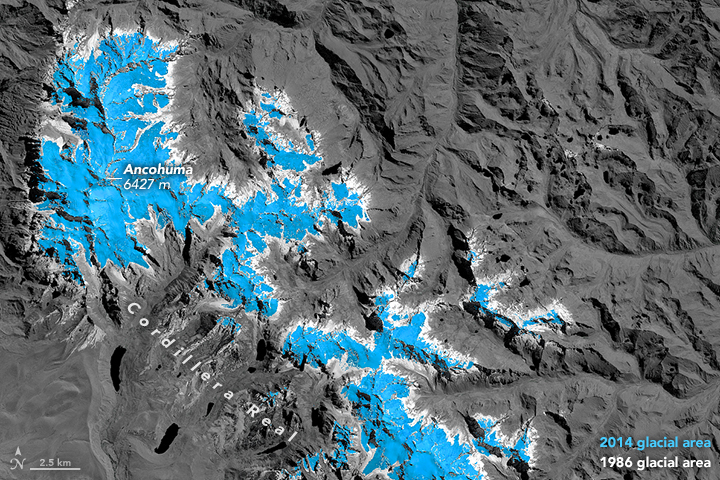
Glacier Change Threatens Andes Communities
Downloads
- Bolivia_oli_2014128_lrg.jpg (2206x2206, JPEG)
Metadata
- Sensor(s):
- Landsat 5 - TM
- Landsat 8 - OLI
- Data Date: July 30, 1986 - May 8, 2014
- Visualization Date: December 20, 2016
In dry, high-altitude locales, glaciers often provide a reliable supply of water. Glacial lakes in the Andes Mountains, for instance, hold water even when the dry season shrinks rivers and lakes in the valleys. But when these giant chunks of ice melt too quickly, the water that pools around them can rush downhill with lethal force.
In the Bolivian Andes, retreating ice and the risk of glacial flooding go hand in hand, according to a new study published in The Cryosphere. Using satellite imagery, scientists identified 25 glacial lakes in the Andes (formed by rising temperatures and glacier melt) that could burst if disturbed by severe weather or other natural events (landslides, avalanches, etc.).
The study found that glaciers in the Cordillera Real mountain range shrank in area by at least 43 percent between 1963 and 2006. The false-color image above, which uses data from the Landsat 8 and Landsat 5 satellites, visualizes some of this ice retreat along this section of the Andes. Among the areas studied, the Cordillera Real had the highest starting glacial area, and experienced the most net change. Glaciers that once covered both the blue and white areas in 1986 shrank to cover just the blue area by 2014. If climate warming continues at the current pace, most of these glaciers will be gone by the end of the 21st century.
“Glacial lakes are basically big water storage tanks,” said Simon Cook, lead author of the study and a glaciologist at Manchester Metropolitan University. If these high-mountain water towers collapse, all their contents could come tumbling down, dislodging boulders and causing rivers to break their banks. Like an avalanche, a glacial flood can scour a valley bottom and wash away entire villages.
While the immediate damage would be devastating, the long-term impact is also worrisome, Cook said. In the dry season, glaciers provide as much as 30 percent of water to La Paz, Bolivia. In late 2016, officials instituted permanent water rations due to a severe drought. According to Al Jazeera, water taps in La Paz sometimes go dry for 60 hours at a time. The disappearance of high-mountain, glacial water sources could deal an additional blow to the city's residents, Cook said.
As climate change brings longer wet and dry spells, the stability of mountain glaciers and their lakes becomes more important. If widespread glacier loss occurs in the Andes, La Paz and cities like it would have to look to other water sources to meet their needs, “instead of drip-feeding populations downstream with water during the dry season.” said Cook.
References and Related Reading
- Al Jazeera (2016, November 20) Water rationing introduced as Bolivia drought worsens. Accessed December 20, 2016.
- Cook, S. J. et al. (2016, October 20) Glacier change and glacial lake outburst flood risk in the Bolivian Andes . Cryosphere. 10 (5194), 2399-2413.
- NASA Earth Observatory (2015, July 27) Glacial Lake Outburst Flood Near Almaty.
- NASA Earth Observatory (2011, March 11) Glacial Lakes of Patagonia.
NASA Earth Observatory image by Joshua Stevens, using Landsat data from the U.S. Geological Survey. Caption by Pola Lem.
This image record originally appeared on the Earth Observatory. Click here to view the full, original record.